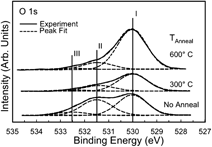Crossref Citations
This article has been cited by the following publications. This list is generated based on data provided by
Crossref.
Rajachidambaram, Jaana S.
Murali, Santosh
Conley, John F.
Golledge, Stephen L.
and
Herman, Gregory S.
2013.
Bipolar resistive switching in an amorphous zinc tin oxide memristive device.
Journal of Vacuum Science & Technology B, Nanotechnology and Microelectronics: Materials, Processing, Measurement, and Phenomena,
Vol. 31,
Issue. 1,
Lee, Yun Seog
Heo, Jaeyeong
Siah, Sin Cheng
Mailoa, Jonathan P.
Brandt, Riley E.
Kim, Sang Bok
Gordon, Roy G.
and
Buonassisi, Tonio
2013.
Ultrathin amorphous zinc-tin-oxide buffer layer for enhancing heterojunction interface quality in metal-oxide solar cells.
Energy & Environmental Science,
Vol. 6,
Issue. 7,
p.
2112.
Rajachidambaram, M. S.
Pandey, A.
Vilayurganapathy, S.
Nachimuthu, P.
Thevuthasan, S.
and
Herman, G. S.
2013.
Improved stability of amorphous zinc tin oxide thin film transistors using molecular passivation.
Applied Physics Letters,
Vol. 103,
Issue. 17,
Al-Hinai, Muna H.
Al-Hinai, Ashraf T.
and
Dutta, Joydeep
2014.
Phase transformation behavior of zinc metastannates obtained by aqueous precipitation at different temperatures.
Journal of Materials Science,
Vol. 49,
Issue. 20,
p.
7282.
Hwang, Daesub
Jin, Jun-Su
Lee, Horim
Kim, Hae-Jin
Chung, Heejae
Kim, Dong Young
Jang, Sung-Yeon
and
Kim, Dongho
2014.
Hierarchically Structured Zn2SnO4 Nanobeads for High-Efficiency Dye-Sensitized Solar Cells.
Scientific Reports,
Vol. 4,
Issue. 1,
Lee, Su-Jae
Hwang, Chi-Sun
Pi, Jae-Eun
Ryu, Min-Ki
Oh, Himchan
Cho, Sung Haeng
Yang, Jong-Heon
Ko Park, Sang-Hee
and
Chu, Hye Yong
2014.
Characterization of ZnO–SnO2 nanocomposite thin films deposited by pulsed laser ablation and their field effect electronic properties.
Materials Letters,
Vol. 122,
Issue. ,
p.
94.
Bora, Tanujjal
Al‐Hinai, Muna H.
Al‐Hinai, Ashraf T.
Dutta, Joydeep
and
Jantzen, C. M.
2015.
Phase Transformation of Metastable ZnSnO3 Upon Thermal Decomposition by In‐Situ Temperature‐Dependent Raman Spectroscopy.
Journal of the American Ceramic Society,
Vol. 98,
Issue. 12,
p.
4044.
Son, Youngbae
Li, Jiabo
and
Peterson, Rebecca L.
2016.
In Situ Chemical Modification of Schottky Barrier in Solution-Processed Zinc Tin Oxide Diode.
ACS Applied Materials & Interfaces,
Vol. 8,
Issue. 36,
p.
23801.
Niang, K. M.
Cho, J.
Heffernan, S.
Milne, W. I.
and
Flewitt, A. J.
2016.
Optimisation of amorphous zinc tin oxide thin film transistors by remote-plasma reactive sputtering.
Journal of Applied Physics,
Vol. 120,
Issue. 8,
Sykora, Benedikt
Wang, Di
and
von Seggern, Heinz
2016.
Multiple ink-jet printed zinc tin oxide layers with improved TFT performance.
Applied Physics Letters,
Vol. 109,
Issue. 3,
Hong, Seunghwan
Oh, Gyujin
and
Kim, Eun Kyu
2017.
Electrical properties of thin film transistors with zinc tin oxide channel layer.
Journal of the Korean Physical Society,
Vol. 71,
Issue. 8,
p.
500.
Niang, Kham M.
Cho, Junhee
Sadhanala, Aditya
Milne, William I.
Friend, Richard H.
and
Flewitt, Andrew J.
2017.
Zinc tin oxide thin film transistors produced by a high rate reactive sputtering: Effect of tin composition and annealing temperatures.
physica status solidi (a),
Vol. 214,
Issue. 2,
p.
1600470.
Minato, Hiroya
Fujiwara, Kohei
and
Tsukazaki, Atsushi
2018.
High-mobility field-effect transistor based on crystalline ZnSnO3 thin films.
AIP Advances,
Vol. 8,
Issue. 5,
Wang, Zhanpeng
Zhang, Shi‐Rui
Zhou, Li
Mao, Jing‐Yu
Han, Su‐Ting
Ren, Yi
Yang, Jia‐Qin
Wang, Yan
Zhai, Yongbiao
and
Zhou, Ye
2019.
Functional Non‐Volatile Memory Devices: From Fundamentals to Photo‐Tunable Properties.
physica status solidi (RRL) – Rapid Research Letters,
Vol. 13,
Issue. 5,
Satoh, Kazuo
Yamada, Yoshiharu
Kanaoka, Yusuke
Murakami, Shuichi
Kakehi, Yoshiharu
and
Sakurai, Yoshiaki
2019.
Investigation on the gate insulator thickness dependence of ZnO–SnO2 thin film transistors.
Japanese Journal of Applied Physics,
Vol. 58,
Issue. 3,
p.
038004.
Zhussupbekova, Ainur
Kaisha, Aitkazy
Vijayaraghavan, Rajani K.
Fleischer, Karsten
Shvets, Igor V.
and
Caffrey, David
2019.
Importance of Local Bond Order to Conduction in Amorphous, Transparent, Conducting Oxides: The Case of Amorphous ZnSnOy.
ACS Applied Materials & Interfaces,
Vol. 11,
Issue. 47,
p.
44399.
Islam, M.A.
Rahman, K.S.
Misran, H.
Asim, N.
Hossain, M.S.
Akhtaruzzaman, M.
and
Amin, N.
2019.
High mobility and transparent ZTO ETM prepared by RF reactive co-sputtering for perovskite solar cell application.
Results in Physics,
Vol. 14,
Issue. ,
p.
102518.
Zhussupbekova, Ainur
Caffrey, David
Zhussupbekov, Kuanysh
Smith, Christopher M.
Shvets, Igor V.
and
Fleischer, Karsten
2020.
Low-Cost, High-Performance Spray Pyrolysis-Grown Amorphous Zinc Tin Oxide: The Challenge of a Complex Growth Process.
ACS Applied Materials & Interfaces,
Vol. 12,
Issue. 41,
p.
46892.
Islam, Mohammad Aminul
Rafiq, Md. Khan Sobayel Bin
Misran, Halina
Uzzaman, Md. Akhtar
Techato, Kuaanan
Muhammad, Ghulam
and
Amin, Nowshad
2020.
Tailoring of the Structural and Optoelectronic Properties of Zinc-Tin-Oxide Thin Films via Oxygenation Process for Solar Cell Application.
IEEE Access,
Vol. 8,
Issue. ,
p.
193560.
Mattson, George W.
Vogt, Kyle T.
Wager, John F.
and
Graham, Matt W.
2022.
Hydrogen incorporation into amorphous indium gallium zinc oxide thin-film transistors.
Journal of Applied Physics,
Vol. 131,
Issue. 10,
